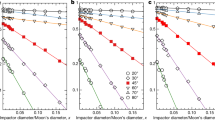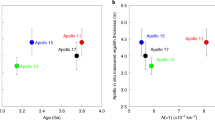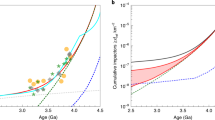Abstract
Owing to its internal ocean, Jupiter’s moon Europa can potentially host extant life. However, because Europa’s orbit is within Jupiter’s magnetosphere, chemical biosignatures that are exposed to space may be destroyed by high-energy electron radiation. It has been suggested that biosignatures may be preserved below the radiation-penetration depth of the top few centimetres. Impact gardening, the process by which small impacts mechanically churn the uppermost surface of airless bodies, is known to disrupt near-surface stratigraphy; however, no comprehensive estimate of the effect of gardening has yet been determined for Europa. Here we use an impact gardening model to show that gardening is a global process on Europa, and has churned, on average, the top 30 cm over the last several tens of millions of years, thus, exposing all material within the top 30 cm to surface radiation. We suggest that morphologically immature craters and regions of mass wasting at mid-to-high latitudes could be weakly impacted by both gardening and radiation, and should be preferred locations for the search for life on Europa.
This is a preview of subscription content, access via your institution
Access options
Access Nature and 54 other Nature Portfolio journals
Get Nature+, our best-value online-access subscription
$29.99 / 30 days
cancel any time
Subscribe to this journal
Receive 12 digital issues and online access to articles
$119.00 per year
only $9.92 per issue
Buy this article
- Purchase on Springer Link
- Instant access to full article PDF
Prices may be subject to local taxes which are calculated during checkout



Similar content being viewed by others
Data availability
All the impact gardening results reported can be reproduced using the equations and parameters provided in this paper. We reference parameters for scaling impactor diameter to crater diameter from table 1 of Costello et al.17. We also reference impact flux information available in Zahnle et al.29, radiation flux information from Nordheim et al.7 and crater size–frequency distributions reported in Bierhaus et al.15,26,27. Source data are provided with this paper.
References
Chyba, C. F. Energy for microbial life on Europa. Nature 403, 381–382 (2000).
Chyba, C. F. & Phillips, C. B. Europa as an abode of life. Orig. Life Evol. Biosph. 32, 47–67 (2002).
Hand, K. P., Chyba, C. F., Priscu, J. C., Carlson, R. W. & Nealson, K. H. in Europa (eds Pappalardo, R. T. et al.) 589–629 (Univ. Arizona Press, 2009).
Sparks, W. B. et al. Probing for evidence of plumes on Europa with HST/STIS. Astrophys. J. 829, 121 (2016).
Sparks, W. B. et al. Active cryovolcanism on Europa? Astrophys. J. Lett. 839, L18 (2017).
Jia, X., Kivelson, M. G., Khurana, K. K. & Kurth, W. S. Evidence of a plume on Europa from Galileo magnetic and plasma wave signatures. Nat. Astron. 2, 459–464 (2018).
Nordheim, T. A., Hand, K. P. & Paranicas, C. Preservation of potential biosignatures in the shallow subsurface of Europa. Nat. Astron. 2, 673–679 (2018).
Swindle, T. D., Masarik, J., Kollár, D., Kim, K. J. & Reedy, R. C. Production of noble gases near the surface of Europa and the prospects for in situ chronology. Icarus 174, 205–214 (2005).
Fruchter, J. S., Rancitelli, L. A., Evans, J. C. & Perkins, R. W. Lunar surface processes and cosmic ray histories over the past several million years. In Lunar and Planetary Science Conference Proceedings Vol. 9, 2019–2032 (Pergamon Press, 1978).
Morris, R. V. In situ reworking/gardening/of the lunar surface-Evidence from the Apollo cores. In Lunar and Planetary Science Conference Proceedings Vol. 9, 1801–1811 (Pergamon Press, 1978).
Cooper, J. F., Johnson, R. E., Mauk, B. H., Garrett, H. B. & Gehrels, N. Energetic ion and electron irradiation of the icy Galilean satellites. Icarus 149, 133–159 (2001).
Ip, W. H., Williams, D. J., McEntire, R. W. & Mauk, B. H. Ion sputtering and surface erosion at Europa. Geophys. Res. Lett. 25, 829–832 (1998).
Molaro, J. L. et al. The microstructural evolution of water ice in the Solar System through sintering. J. Geophys. Res. Planets 124, 243–277 (2019).
Moore, J. M. et al. in Europa (eds Pappalardo, R. T. et al.) 329–349 (Arizona Univ. Press, 2009).
Bierhaus, E. B., Chapman, C. R. & Merline, W. J. Secondary craters on Europa and implications for cratered surfaces. Nature 437, 1125–1127 (2005).
Costello, E. S., Ghent, R. R. & Lucey, P. G. The mixing of lunar regolith: vital updates to a canonical model. Icarus 314, 327–344 (2018).
Costello, E. S., Ghent, R. R., Hirabayashi, M. & Lucey, P. G. Impact gardening as a constraint on the age, source, and evolution of ice on Mercury and the Moon. J. Geophys. Res. Planets 125, e2019JE006172 (2020).
Minton, D. A., Fassett, C. I., Hirabayashi, M., Howl, B. A. & Richardson, J. E. The equilibrium size-frequency distribution of small craters reveals the effects of distal ejecta on lunar landscape morphology. Icarus 326, 63–87 (2019).
Gault, D. E., Hörz, F., Brownlee, D. E. & Hartung, J. B. Mixing of the lunar regolith. Lunar and Planetary Science Conference Proceedings Vol. 5, 2365–2386 (Pergamon Press, 1974).
Hartmann, W. K. & Gaskell, R. W. Planetary cratering 2: Studies of saturation equilibrium. Meteorit. Planet. Sci. 32, 109–121 (1997).
Xiao, Z. & Werner, S. C. Size-frequency distribution of crater populations in equilibrium on the Moon. J. Geophys. Res. Planets 120, 2277–2292 (2015).
Hirabayashi, M., Minton, D. A. & Fassett, C. I. An analytical model of crater count equilibrium. Icarus 289, 134–143 (2017).
Arnold, J. R. Monte Carlo simulation of turnover processes in the lunar regolith. In Lunar and Planetary Science Conference Proceedings Vol. 6, 2375–2395 (Pergamon Press, 1975).
McEwen, A. S. et al. The rayed crater Zunil and interpretations of small impact craters on Mars. Icarus 176, 351–381 (2005).
Holsapple, K. A. The scaling of impact processes in planetary sciences. Annu. Rev. Earth Planet. Sci. 21, 333–373 (1993).
Bierhaus, E. B., Chapman, C. R., Merline, W. J., Brooks, S. M. & Asphaug, E. Pwyll secondaries and other small craters on Europa. Icarus 153, 264–276 (2001).
Bierhaus, E. Discovery That Secondary Craters Dominate Europa’s Small Crater Population. PhD thesis, Univ. Colorado (2004).
Speyerer, E. J., Povilaitis, R. Z., Robinson, M. S., Thomas, P. C. & Wagner, R. V. Quantifying crater production and regolith overturn on the Moon with temporal imaging. Nature 538, 215–218 (2016).
Zahnle, K., Schenk, P., Levison, H. & Dones, L. Cratering rates in the outer Solar System. Icarus 163, 263–289 (2003).
Zahnle, K., Dones, L. & Levison, H. F. Cratering rates on the Galilean satellites. Icarus 136, 202–222 (1998).
Levison, H. F., Duncan, M. J., Zahnle, K., Holman, M. & Dones, L. Planetary impact rates from ecliptic comets. Icarus 143, 415–420 (2000).
Tsuji, D. & Teanby, N. A. Europa’s small impactor flux and seismic detection predictions. Icarus 277, 39–55 (2016).
Hueso, R. et al. Impact flux on Jupiter: From superbolides to large-scale collisions. Astron. Astrophys. 560, A55 (2013).
Howell, S. M. & Pappalardo, R. T. Band formation and ocean‐surface interaction on Europa and Ganymede. Geophys. Res. Lett. 45, 4701–4709 (2018).
Nishiizumi, K., Welten, K. C. & Caffee, M. W. Recent deposition and mixing history of the Apollo 17 drill core 70009-70001. In Lunar and Planetary Science Conference 2132 (Lunar and Planetary Institute, 2019).
Acknowledgements
This work was supported and facilitated by a summer internship with the National Aeronautics and Space Administration (NASA) Jet Propulsion Laboratory (JPL) Summer Internship Program and by a NASA Solar System Workings Program grant to the University of Hawaii (grant number 6107932: ‘An Analytic Model for Impact Gardening Across the Solar System’; to E.S.C., R.R.G. and P.G.L.). E.S.C. and C.B.P. were partially funded by the Europa Lander Mission Concept at JPL.
Author information
Authors and Affiliations
Contributions
E.S.C. was the primary contributor to the development of the model described in this work, produced the figures, performed the scientific analysis and wrote the manuscript. C.B.P. contributed to the formulation of the scientific question addressed in this work, the scientific analysis, and the editing and revision of the manuscript. R.R.G. contributed to the model development and execution and to the editing and revision of the manuscript. P.G.L. contributed by securing the funding that supported this work, by assisting in model development, and to the editing and revision of the manuscript.
Corresponding author
Ethics declarations
Competing interests
The authors declare no competing interests.
Additional information
Peer review information Nature Astronomy thanks Mihaly Horanyi, Micah Schaible and the other, anonymous, reviewer(s) for their contribution to the peer review of this work.
Publisher’s note Springer Nature remains neutral with regard to jurisdictional claims in published maps and institutional affiliations.
Source data
Source Data Fig. 1
Cumulative crater count data and model solutions to reproduce the plot in Fig. 1.
Source Data Fig. 2
Impact gardening model results as a function of probability, including cumulative Poisson distribution values for λ, and gardening calculations as a function of time.
Source Data Fig. 3
Impact gardening results as a function of probability using the Bierhaus et al. crater counts.
Rights and permissions
About this article
Cite this article
Costello, E.S., Phillips, C.B., Lucey, P.G. et al. Impact gardening on Europa and repercussions for possible biosignatures. Nat Astron 5, 951–956 (2021). https://doi.org/10.1038/s41550-021-01393-1
Received:
Accepted:
Published:
Issue Date:
DOI: https://doi.org/10.1038/s41550-021-01393-1
This article is cited by
-
Oxygen production from dissociation of Europa’s water-ice surface
Nature Astronomy (2024)



